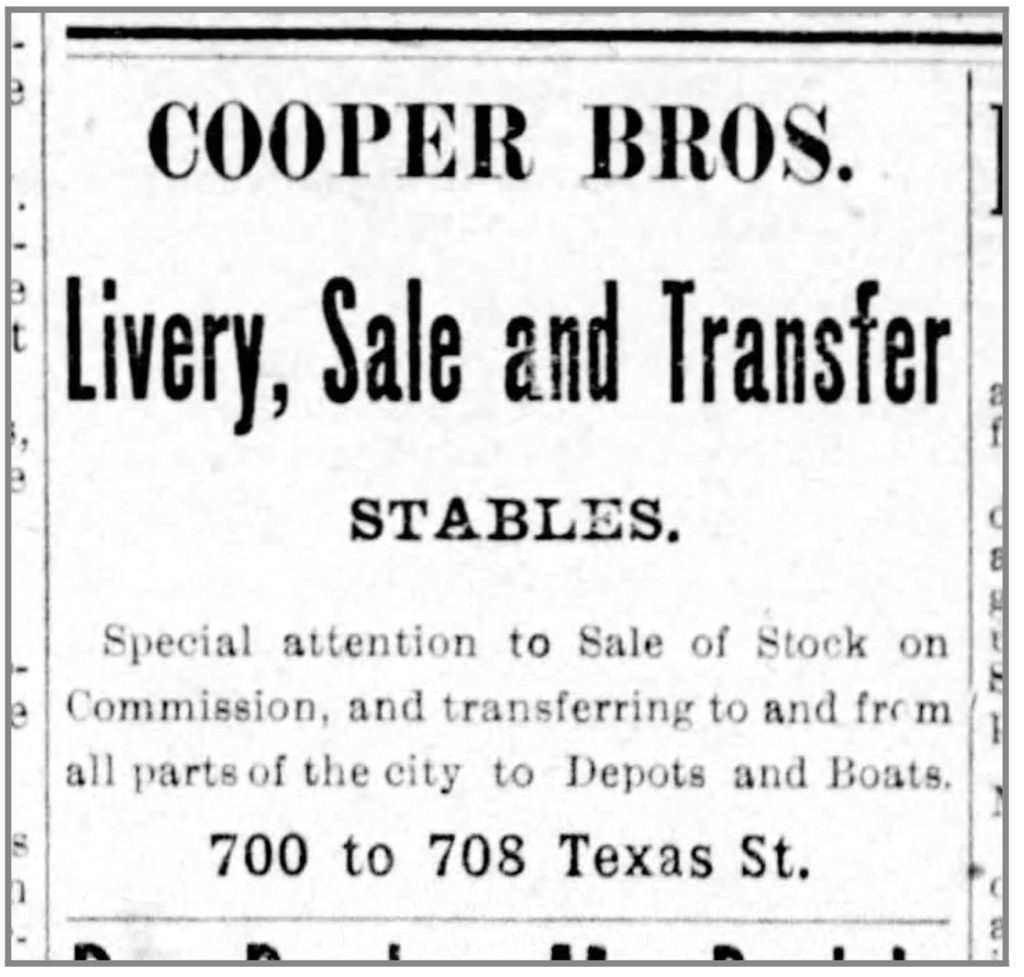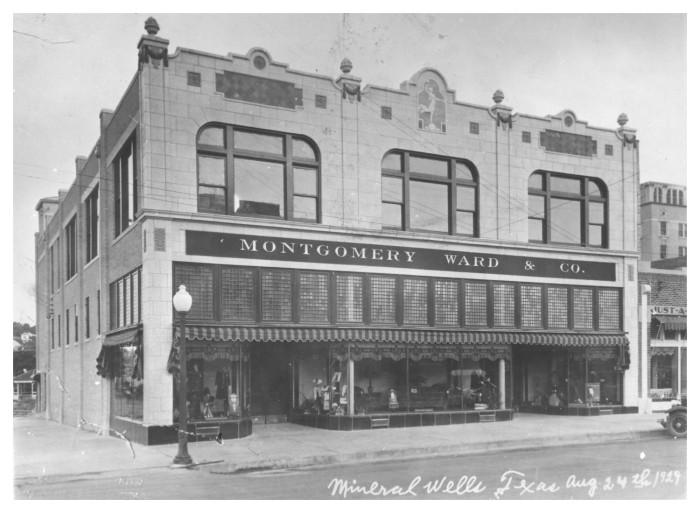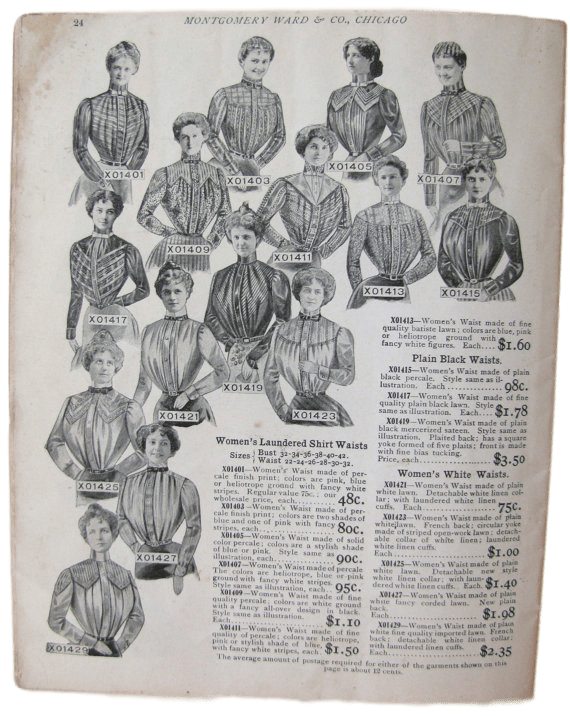Given as a History in 5 talk at the June 2019 Downtown Artwalk.
Those of you who have heard my talks before know that downtown is an archeological dig. Nothing that is here now was the first thing here…sometimes there are several levels to dig down on and multiple buildings that have occupied one single address.

The same is true in the 700 block of Texas Street. When you look back in the city directories at the history of that block, it’s amazing what was there. Mr. W.T. Jackson had a house there in 1890 and then it was Cooper’s Mammoth Mule Yard. A theater was there, a sign shop, a shoe store, a bakery…uses of buildings sometimes changed multiple times in the space of a year as businesses came and went. All those business changes stopped in 1929 when the new Montgomery Ward store was built at 708 Texas St.

Montgomery Ward was founded by Aaron Montgomery Ward and Andrew Ward in 1872. Aaron was a traveling salesman whose route was out in the country. His customers wanted ‘city’ goods, but the only place they could get them was in the little Mom and Pop stores in the tiny villages nearby, but the selection was small and the prices were high. Aaron figured out a way to cut out the middleman by creating a catalog where his customers would be able to order direct. This was a first  and it was huge. To put it in perspective, Aaron became Wal-Mart and Amazon all rolled into one and people hated him. In fact, rural retailers started BURNING his catalogs.
and it was huge. To put it in perspective, Aaron became Wal-Mart and Amazon all rolled into one and people hated him. In fact, rural retailers started BURNING his catalogs.
Aaron hung in, and by 1883, his catalog had become known as the “Wish Book” and contained 10,000 items in 240 pages. It was truly a one-stop form of shopping; catalogs featured everything from gloves to ‘Magic Lantern’ cameras to bicycles and buggies to house plans and furniture. (By 1904, the company was mailing 3 million catalogs that weighed 4 pounds each.) Ward’s policy of ‘Satisfaction Guaranteed or Your Money Back’ was almost unheard of at the time. Other businesses were paying attention and in 1896, Ward’s saw their first serious competition from a man named Richard Warren Sears.

In 1926, Montgomery Ward opened its first retail store in Indiana – by 1930, when the store in downtown Shreveport was completed, there were 531 retail stores. If you had walked into the Shreveport store, you would have found Pioneer Overalls for $1.29  and men’s pin checked pants at the bargain price of $.88. You could have ordered a solid roll top desk for $27.95, or a metal bed with mattress for $26.95. Yes, those prices are low, but remember the context of the time. In 1930, your average income would have been $2,196 a year and your life expectancy would have been about 54 years.
and men’s pin checked pants at the bargain price of $.88. You could have ordered a solid roll top desk for $27.95, or a metal bed with mattress for $26.95. Yes, those prices are low, but remember the context of the time. In 1930, your average income would have been $2,196 a year and your life expectancy would have been about 54 years.

When you drive across America, you will see many buildings that look much like artspace, buildings with cream-colored facades and green tiles because the same Art Deco façade was replicated over and over. 
When you look up toward the roof, you will see the Montgomery Ward muse, “Progress Lighting the Way for Commerce.” Sculptor J. Massey Rhind created the design, which was made expressly for Ward’s by the Atlantic Terra Cotta Company.
Montgomery Ward is notable for something else, too. In 1939, as part of a Christmas promotional campaign, staff copywriter Robert L. May created the character and an illustrated poem of Rudolph, the Red-Nosed Reindeer. Montgomery Ward had high hopes for the 32-page, illustrated booklet, which would be given as a free gift to children visiting any of the department store’s 620 locations. Children snapped up nearly 2.4 million copies of the paper-bound book in 1939.

In 1985, the company closed its catalog business, and on Dec. 28, 2000 announced it would cease operating. According to the City Directories, our Montgomery Ward had moved by 1940 and the building became a series of other furniture stores including JC Penney and the American Furniture Company. In 1959, there was a serious fire at the building and damage was substantial. By 1990, it was Smith Furniture, then in 1991, Ivan Smith Furniture…his very first. By 2002, the building was vacant, and looking pretty forlorn, so the Downtown Development Authority and the Downtown Shreveport Development Corporation went to Mr. Smith and asked him to consider selling the building to them so that they could rehab the building to try to create a spark for the West Edge Arts District.
 DDA/DSDC had already done the same thing in the 600 block with the Robinson Film Center (we bought and rehabbed the building and found an exciting tenant) and wanted to keep up the progress created with that. Though the building had serious sentimental value to the Smiths, they agreed to sell and in 2002, DDA/DSDC spent spent $700,000 on acquisition and rehab to create artspace, a multi-disciplinary arts center. SRAC raised additional funds to finish rehab and build out the center, and most recently, worked to raise funds to rehab the section that is now the PepitoXO restaurant.
DDA/DSDC had already done the same thing in the 600 block with the Robinson Film Center (we bought and rehabbed the building and found an exciting tenant) and wanted to keep up the progress created with that. Though the building had serious sentimental value to the Smiths, they agreed to sell and in 2002, DDA/DSDC spent spent $700,000 on acquisition and rehab to create artspace, a multi-disciplinary arts center. SRAC raised additional funds to finish rehab and build out the center, and most recently, worked to raise funds to rehab the section that is now the PepitoXO restaurant.

We love our old Montgomery Ward, now artspace. It is a wonderful building filled with art, wonder, and surprises, and we hope you will visit it soon!



